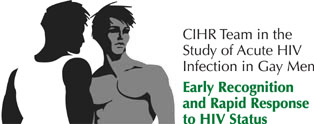
Funding Provided By
What is Acute HIV Infection (AHI)?
Acute HIV infection, sometimes called primary infection, can be described as a time of brief but substantially increased risk for HIV transmission resulting from very high viral loads occurring in the first couple of months post-infection.
When someone get exposed and infected with HIV, the amount of HIV in the blood, cum and pre-cum, gets very high within a few days. What’s happening is that the HIV virus is replicating itself very quickly, making an individual much more likely to infect someone else if risk behaviours occur.
The acute HIV phase usually lasts about 8 weeks, but varies from person to person. Once the body begins to produce HIV antibodies, the amount of HIV drops to a lower and more stable level. The individual is still able to pass on the virus, but the likelihood of transmission decreases.
Symptoms of Acute HIV Infection (AHI)?
About half of the people who get infected with HIV don’t notice any signs or symptoms that they have been infected. If symptoms do arise, they generally occur within 2 to 4 weeks. The most common symptoms are fever, fatigue, and rash. Others include headache, swollen lymph glands, sore throat, feeling achy, nausea, vomiting, diarrhea, and night sweats.
It is easy to overlook the signs of acute HIV infection as they can be caused by several different illnesses; many people think it is just a bad case of the flu.
What is the Importance of AHI in Transmission of HIV?
Growing evidence strongly suggests that a significant proportion of all new infections arise from highly infectious, acutely-infected individuals who have recently acquired HIV. For example, the results of a recent study of a predominantly MSM cohort in Quebec suggest that persons in the early stages of infection accounted for approximately half of onward transmissions in this population. Other studies have shown that persons with acute HIV infection generate between 11% and 49% of all new infections depending on the stage of the epidemic, the rate of partner change and partner concurrency.
